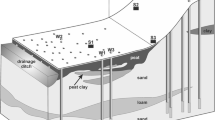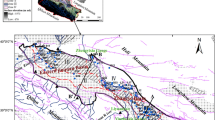Abstract
Eight groundwater observation wells were installed along the river plain, where the landscapes varied from floodplain, to oasis farmland, to desert-oasis ecotone to desert, in a typical desert-oasis ecotone in northwestern China. Ten years of data were used to analyze temporal and spatial changes in the groundwater depth. The results indicated that in the last decade: (1) the groundwater depths in the floodplain (GW1) and the desert (GW8) were basically stable; (2) the groundwater depths in the oasis farmland (GW2, GW3, GW4) increased dramatically: the annual fluctuations were 1.43, 1.01 and 0.79 m respectively, with the groundwater depths increasing by 0.13–0.18 m every year; (3) the groundwater depths in the desert-oasis ecotone (GW5, GW6, GW7) also increased dramatically: the annual fluctuations were 1.10, 1.06 and 1.05 m respectively, and the depths increased by 0.10–0.15 m every year; (4) the influence distance between the river and both the farmland and the desert-oasis ecotone was about 1000–2000 m in the study area. These results show that the natural seasonal fluctuation influence on groundwater depths was not significant, but the human-induced fluctuations such as intensive irrigation caused a significant increase in groundwater depth in both the farmland and the desert-oasis ecotone, seriously affecting sustainable agriculture development and the environment, in the oasis.




Similar content being viewed by others

References
Alley W M, Healey R W, LaBaugh J W and Reilly T E 2002 Flow and storage in groundwater systems; Science 296 1985–1990.
Allen D M, Mackie D C and Wei M 2004 Groundwater and climate change: A sensitivity analysis for the Grand Forks aquifer, southern British Columbia, Canada; Hydrol. J. 12 270–290.
Ao F, Yu J J, Wang P and Zhang Y C 2012 Changing characteristics and influencing causes of groundwater level in the lower reaches of the Heihe River; J. Natur. Res. 27 686–696 (in Chinese).
Ashland F X, Giraud R E and McDonald G N 2005 Open-file report (Utah Geological Survey); 448 US Dept. of the Interior, Salt Lake City, Utah.
Chen X L 2006 The ecological water dispatching in the Heihe River from 2000 to 2004; J. Arid Land Res. Environ. 2 106–110.
Cheng G D, Li X, Zhao W Z, Xu Z M, Feng Q, Xiao S C and Xiao H L 2014 Integrated study of the water–ecosystem–economy in the Heihe River Basin; NSR 1 413–428.
Dawson T E and Ehleringer J R 1991 Stream trees that do not use stream water; Nature 350 335–337.
Green T, Taniguchi M, Kooi H, Gurdak J, Hiscock K, Allen D M, Treidel H and Aureli A 2011 Beneath the surface of global change: Impacts of climate change on groundwater; J. Hydrol., doi: 10.1016/j.jhydrol.2011.05.002.
Gao Q Z, Li X Y and Wu Y Q 2004 Transformation of water resources in the inland river basins of Hexi Region; J. Glaciol. Geocry 26 48–54 (in Chinese).
Jiang X H and Liu C M 2009 The response of vegetation to water transport in the lower reaches of the Heihe River; Acta Geogr. Sin 64 791–797 (in Chinese).
Jury W A and Vaux H . 2005 The role of science in solving the world’s emerging water problems; P. Natl. Acad. Sci. USA 102 15,715–15,720.
Li Q S and Zhao W Z 2004 Effect of water allocation of the Heihe River on plan structure and stable development of the ecosystem in the Linze Oasis, Gansu – a case study in the Pingchuan irrigation district in Linze County at the middle reaches of the Heihe River; J. Glaciol. Geocry 26 333–343 (in Chinese).
Liu Y M and Zhao Z F 2010 The response of Ejina County ecological environment on water transfer in lower reaches of Heihe River; Inner Mongolia Meteorol 1 8–41 (in Chinese).
Oki T and Kanae S 2006 Global hydrological cycles and world water resources; Science 313 1068–1072.
Siebert S 2010 Groundwater use for irrigation – a global inventory; HESS 7 3977–4021.
Scanlon B R, Faunt C C, Laurent L, Reedy R C, Alley W M, McGuire V L and McMahon P B 2012 Groundwater depletion and sustainability of irrigation in the US High Plains and Central Valley; PNAS 109 9320– 9325.
Shiklomanov I A 2000 Appraisal and assessment of world water resources; Water Int. 25 11–32.
Synder K A and William D C 2000 Water resources used by riparian trees varies among stream types on the Pedro River, Arizona; Agric. For. Meteorol. 105 227–240.
Si J H, Feng Q, Zhang X Y, Su Y Y and Zhang Y W 2005 Vegetation changes in the lower reaches of the Heihe River after its water import; Acta Botan. Boreal Sin. 25 631–640 (in Chinese).
Taniguchi M and Holman I P 2010 Groundwater response to changing climate; CRC Press, Boca Raton, London, New York, Leiden, 232p.
WWAP 2009 The United Nations World Water Development Report 3: Water in a changing world, World Water Assessment Programme; Paris: UNESCO Publishing, UNESCO 349.
Wang W G, Xue X Z and Geng W 2007 Spatial variability of water level in Hetao irrigation district of inner Monglia and their estimations by the Kriging; J. Irrig. Drain. 26 18–21 (in Chinese).
Xu H L, Chen Y N and Li W H 2003 Study on response of groundwater after ecological water transport at the lower reaches of the Tarim River; Res. Environ. Sci. 16 19–22.
Zhao C Y, Li S B and Feng Z D 2009 Dynamics of groundwater level in the water table fluctuant belt at the lower reaches of Heihe River; J. Desert. Res. 29 365–369 (in Chinese).
Zhao H L, Zhao X Y and Zhang T H 2002 The changing dynamics of groundwater and its relationship with the precipitation and desertification in the western part of northeast China since recent 20 years; Arid Zone Res. 19 1–6 (in Chinese).
Zhang J Y, Wang G Y and He R M 2009 Variation trends of runoffs in the middle Yellow River basin and its response to climate change; Adv. Water Sci. 20 153–158 (in Chinese).
Zhang L W and Yan J P 2010 Analysis on the relationship between groundwater table varying trend with climate change in Xianyang – a case study in Loess plateau area at two sides of Jinghe River; J. Water Res. Water Eng. 21 102–105.
Acknowledgements
We would like to thank Marian Rhys for the English language review. This project was supported by the Outstanding Youth Foundation Project, National Natural Science Foundation of China (No. 41125002).
Author information
Authors and Affiliations
Corresponding author
Rights and permissions
About this article
Cite this article
Wang, G., Zhao, W. The spatio-temporal variability of groundwater depth in a typical desert-oasis ecotone. J Earth Syst Sci 124, 799–806 (2015). https://doi.org/10.1007/s12040-015-0571-z
Received:
Revised:
Accepted:
Published:
Issue Date:
DOI: https://doi.org/10.1007/s12040-015-0571-z



